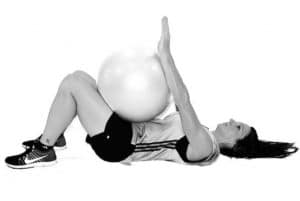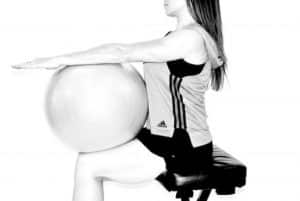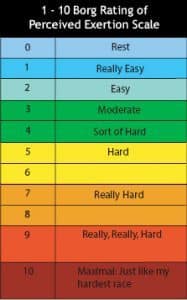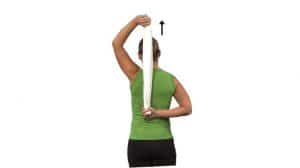 When you begin to work with a new client, especially a cancer survivor, the first 2 weeks are incredibly important in setting the stage for a longer term program.
When you begin to work with a new client, especially a cancer survivor, the first 2 weeks are incredibly important in setting the stage for a longer term program.
This example 2 week program will help guide you through your first two weeks as a current or prospective Cancer Exercise Specialist working with a client who has a medical clearance to begin exercising, and provides an overview of the detailed exercise concepts you will learn with the Cancer Exercise Specialist Advanced Qualification.
First and foremost, patients MUST discuss exercise with their doctor and complete a MEDICAL CLEARANCE FORM. This will state any limitations or modifications that will be necessary in their exercise programming. If they were sedentary prior to their cancer diagnosis, you may need to have them work at a lower intensity. If they were active prior to their diagnosis, you may be able to push them a bit harder.
Your client should be at least 6 weeks post-op before beginning an exercise program consisting of anything more than range of motion, stretching, and breathing exercises.
Lymph Drainage Exercises for Upper Extremity Lymphedema Prevention and Management
Prior to beginning these exercises, clients should start with a five-minute aerobic warm-up, which can be walking, treadmill time, stationary biking or other aerobic activity that the client is capable of with relative ease. As they begin each of the following exercises make sure to have them take several deep abdominal breaths.
- Pelvic tilt – have your client/patient lie on their back with their knees bent and feet flat on the floor. Have them tilt their hips so that they are able to press the small of their back against the floor. Have them pause for several seconds then release the contraction. Repeat 5-10 times.
- Modified sit–up – have your client/patient lie on their back with their knees bent and feet flat on the floor. Instruct them to maintain a neutral pelvis. Have them keep their neck in neutral and their chin pointing to the ceiling. As they exhale, have them lift up their chest and shoulders, pausing when they feel their abdominal muscles tighten up. Have them slowly lower themselves back to starting position (trying not to rest between repetitions). Repeat as many times as they can comfortably.
- **If your client/patient has a bad neck they can place a 55cm exercise ball on their stomach and against their bent legs. Keeping their arms straight and reaching toward ceiling, and their head relaxed on the floor, they should engage their abdominal muscles and press their arms against the ball. They can repeat this as many times as they can comfortably. This can also be done sitting upright in a chair (only the ball will be on their lap and their arms will be parallel to the floor) for someone who is unable to get to the ground.
- Neck stretches – instruct your client to tuck their chin to their chest and gently place their hands on the back of their head.; letting the weight of their hands add to the stretch – hold for 20-30 seconds. Next instruct them to tilt their right ear to their right shoulder, with their left arm bent behind their back. Have them gently place their hand over their left ear; letting the weight of their hand add to the stretch – hold for 20-30 seconds and repeat on the other side.These stretches can be done by the client/patient, or with assistance from the CES.
- Shoulder shrugs – have your client/patient shrug both shoulders, lifting them towards their ears as they inhale. Have them exhale, and depress their shoulders as low as they can (attempting to reach the floor with their fingertips) then return to a relaxed position. Repeat 5-10 times.
- Shoulder rolls – have your client/patient lift their shoulders up to the ears then rotate the shoulders back and down, making a smooth, continuous motion. Repeat 5-10 in each direction.
- Isometric shoulder blade squeeze – have your client/patient bend their elbows at 45-90 degrees out at their sides (parallel to the floor). Have them exhale and pull them towards the center of your back, squeezing the shoulder blades together. Pause. Have them inhale and return to starting position. Repeat 5-10 times.
- Isometric chest-press – have your client/patient place the palms of their hands together, with their elbows bent and arms at or below shoulder level. Have them exhale and push their hands firmly together. Pause. Have them inhale and relax. Repeat 5-10 times.
- Shoulder circles – have your client/patient hold their arms at or below shoulder height with their palms facing down. Have them make small circles with their arms (keeping arms elevated). Repeat 5-10 times in each direction.
- Wrist circles – have your client/patient hold their arms overhead and rotate their fist in small circles, isolating the movement to the wrist only. Rotate 5-10 times in each direction.
- Wrist flexion and extension – have your client/patient hold their arms overhead and flex and extend their wrists, isolating the movement to the wrist only. Repeat 5-10 times.
- Fist clench – have your client/patient hold their arms overhead and open their hands and stretch their fingers, spreading them apart. Then have them slowly clench each hand to make a fist. Pause. Repeat 5-10 times.
Use the following scale to determine perceived exertion (RPE):
Week One
Day 1
1) Have your client begin with 5 minutes of cardiovascular exercise working at a 4-5 RPE.
2) If client has had lymph nodes removed or irradiated, have them perform lymph drainage exercises listed above.
3) If shoulder ROM is limited, they should perform the following ROM stretches and hold for 20-30 seconds. They should only feel a mild stretching sensation – NO PAIN.

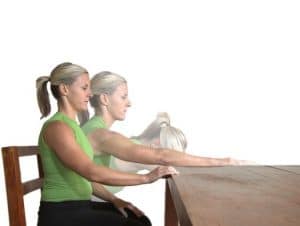
4) Choose one balance exercise that your client can gradually and safely progress toward something more challenging.
Day 2
1) Have your client begin with 5 minutes of cardiovascular exercise working at a 4-5 RPE.
2) If client has had lymph nodes removed or irradiated, have them perform lymph drainage exercises listed above.
3) If shoulder ROM is limited, they should perform the ROM stretches and hold for 20-30 seconds. They should only feel a mild stretching sensation – NO PAIN.
Day 3
1) Have your client begin with 5 minutes of cardiovascular exercise working at a 4-5 RPE.
2) If client has had lymph nodes removed or irradiated, have them perform lymph drainage exercises listed above.
3) If shoulder ROM is limited, they should perform the ROM stretches and hold for 20-30 seconds. They should only feel a mild stretching sensation – NO PAIN.
4) Repeat original balance exercise that your client can gradually and safely progress toward something more challenging.
Day 4
Encourage your client to do something that they enjoy doing; hiking, biking, yoga, dance, etc. Instruct them to minimize repetitive motions with their upper body (bowling, tennis, golfing…), as this may increase their risk of lymphedema. Encourage them to do a five-minute gentle warm-up prior to their exercise of choice, and finish with lymph drainage exercises.
Day 5
1) Have your client begin with 5 minutes of cardiovascular exercise working at a 4-5 RPE.
2) If client has had lymph nodes removed or irradiated, have them perform lymph drainage exercises listed above.
3) If shoulder ROM is limited, they should perform the ROM stretches and hold for 20-30 seconds. They should only feel a mild stretching sensation – NO PAIN.
4) Repeat original balance exercise that your client can gradually and safely progress toward something more challenging. If they are strong, confident, and have good form, consider a balance progression.
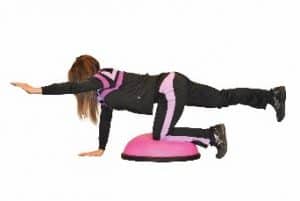
Day 6
1) Have your client begin with 5 minutes of cardiovascular exercise working at a 4-5 RPE.
2) If client has had lymph nodes removed or irradiated, have them perform lymph drainage exercises listed above.
3) If shoulder ROM is limited, they should perform the ROM stretches and hold for 20-30 seconds. They should only feel a mild stretching sensation – NO PAIN.
4) Add a lower body functional exercise like a squat or lunge. Begin with fundamentals. Explain form, positioning, and pain-free movement. Look for compensations like varus/valgus knees, heels lifting, excessive arching of lower back, arms dropping etc.. Make appropriate corrections in biomechanics before progressing to next level.
Day 7
Rest and recover.
Remember to educate your client about lymphedema prevention and identification. If there is any noticeable swelling they MUST see their physician before continuing to exercise. They MUST return with a medical clearance form before resuming training. If they have been prescribed a compression garment, they MUST wear it to training.
Week Two
Day 1
1) Have your client begin with 5-7 minutes of cardiovascular exercise working at a 5-6 RPE.
2) If client has had lymph nodes removed or irradiated, have them perform lymph drainage exercises listed above.
3) If shoulder ROM is limited, they should perform the ROM stretches and hold for 20-30 seconds. They should only feel a mild stretching sensation – NO PAIN.
4) Continue to improve upon lower body functional exercise. Make appropriate corrections in biomechanics before progressing to next level.
Day 2
1) Have your client begin with 5-7 minutes of cardiovascular exercise working at a 5-6 RPE.
2) If client has had lymph nodes removed or irradiated, have them perform lymph drainage exercises listed above.
3) If shoulder ROM is limited, they should perform the ROM stretches and hold for 20-30 seconds. They should only feel a mild stretching sensation – NO PAIN.
4) Continue to improve upon lower body functional exercise. Make appropriate corrections in biomechanics before progressing to next level.
5) Add an upper body exercise, based on postural assessment, starting with isometrics. Instruct your client on proper form, contracting appropriate muscle groups, and breathing. Begin with 6-8 repetitions.
Day 3
1) Have your client begin with 5-7 minutes of cardiovascular exercise working at a 5-6 RPE.
2) If client has had lymph nodes removed or irradiated, have them perform lymph drainage exercises listed above.
3) If shoulder ROM is limited, they should perform the ROM stretches and hold for 20-30 seconds. They should only feel a mild stretching sensation – NO PAIN.
4) Continue to improve upon lower body functional exercise. Make appropriate corrections in biomechanics before progressing to next level.
5) Add an upper body exercise, based on postural assessment, starting with isometrics. Instruct your client on proper form, contracting appropriate muscle groups, and breathing. Begin with 6-8 repetitions.
Day 4
Encourage your client to do something that they enjoy doing; hiking, biking, yoga, dance, etc. Instruct them to minimize repetitive motions with their upper body (bowling, tennis, golfing…), as this may increase their risk of lymphedema. Encourage them to do a five-minute gentle warm-up prior to their exercise of choice, and finish with lymph drainage exercises.
Day 5
1) Have your client begin with 5-7 minutes of cardiovascular exercise working at a 5-6 RPE.
2) If client has had lymph nodes removed or irradiated, have them perform lymph drainage exercises listed above.
3) If shoulder ROM is limited, they should perform the ROM stretches and hold for 20-30 seconds. They should only feel a mild stretching sensation – NO PAIN.
4) Continue to improve upon lower body functional exercise. Make appropriate corrections in biomechanics before progressing to next level.
5) Continue with upper body exercise using isometrics. Instruct your client on proper form, contracting appropriate muscle groups, and breathing. Have them perform 6-8 repetitions.
Day 6
Rest and recover.
Day 7
1) Have your client begin with 5-7 minutes of cardiovascular exercise working at a 5-6 RPE.
2) If client has had lymph nodes removed or irradiated, have them perform lymph drainage exercises listed above.
3) If shoulder ROM is limited, they should perform the ROM stretches and hold for 20-30 seconds. They should only feel a mild stretching sensation – NO PAIN.
4) Continue to improve upon lower body functional exercise. Make appropriate corrections in biomechanics before progressing to next level.
5) Continue with upper body exercise using isometrics. Instruct your client on proper form, contracting appropriate muscle groups, and breathing. Have them perform 8-10 repetitions.

